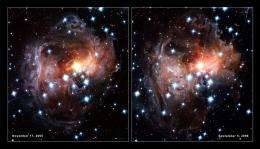Planets smashed into dust near supermassive black holes

(PhysOrg.com) -- Fat doughnut-shaped dust shrouds that obscure about half of supermassive black holes could be the result of high speed crashes between planets and asteroids, according to a new theory from an international team of astronomers. The scientists, led by Dr. Sergei Nayakshin of the University of Leicester, publish their results in the journal Monthly Notices of the Royal Astronomical Society.
Supermassive black holes reside in the central parts of most galaxies. Observations indicate that about 50% of them are hidden from view by mysterious clouds of dust, the origin of which is not completely understood. The new theory is inspired by our own Solar System, where the so-called zodiacal dust is known to originate from collisions between solid bodies such as asteroids and comets. The scientists propose that the central regions of galaxies contain not only black holes and stars but also planets and asteroids.
Collisions between these rocky objects would occur at colossal speeds as large as 1000 km per second, continuously shattering and fragmenting the objects, until eventually they end up as microscopic dust. Dr. Nayakshin points out that this harsh environment - radiation and frequent collisions - would make the planets orbiting supermassive black holes sterile, even before they are destroyed. "Too bad for life on these planets", he says, "but on the other hand the dust created in this way blocks much of the harmful radiation from reaching the rest of the host galaxy. This in turn may make it easier for life to prosper elsewhere in the rest of the central region of the galaxy."
He also believes that understanding the origin of the dust near black holes is important in our models of how these monsters grow and how exactly they affect their host galaxies. "We suspect that the supermassive black hole in our own Galaxy, the Milky Way, expelled most of the gas that would otherwise turn into more stars and planets", he continues, "Understanding the origin of the dust in the inner regions of galaxies would take us one step closer to solving the mystery of the supermassive black holes".
More information: The new work is published in "Are SMBHs shrouded by "Super-Oort" clouds of comets and asteroids?", Nayakshin S., et al., Monthly Notices of the Royal Astronomical Society, in press. A preprint of the paper can be seen at arxiv.org/abs/1109.1217
Provided by Royal Astronomical Society














.jpg)






